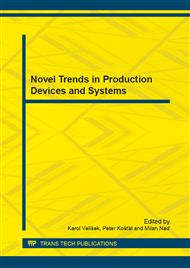p.273
p.279
p.285
p.291
p.297
p.303
p.309
p.315
p.321
Examination of Temperature and Stress Fields in the Welding Process
Abstract:
On the basis of large changes in temperature during the welding process technology, there is a shape change or welded parts of tensions. Stress and deformation of the welded material formed as a result of heat delivered to the weld zone and its surroundings. Uneven heating or cooling, and fixed mounting welded parts may cause the formation of stress in welded material during the welding process. Causing local, or overall deformation of welded parts. That is why it is necessary to know the temporal distribution of temperature and stress generated during welding. Stress or strain cycle is the result of welding thermal cycles. It is possible to determine the time courses of thermal cycles with different methods. The most commonly used method are experimental, analytical and numerical. Currently most often to predict stresses and deformations using the methods of the modeling and numerical simulation used FEM. Which any application methods for solving specific problems in the field of welding, it is possible to obtain such results. Such as residual thermal stress and deformation of welded materials or changes in the structure of the different phases of the material in the heat affected zone (HAZ). The residual thermal stress and deformation, changes of phase structure of the material in the heat affected zone have a great impact on the quality and strength of the weld joint.
Info:
Periodical:
Pages:
297-302
Citation:
Online since:
January 2014
Authors:
Keywords:
Price:
Сopyright:
© 2014 Trans Tech Publications Ltd. All Rights Reserved
Share:
Citation:


